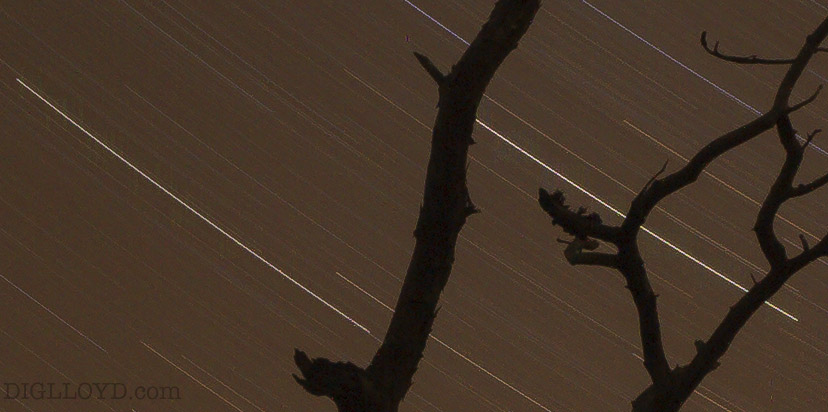Sony’s 11+7-bit LOSSY File Compression: 32-pixel Line Artifacts Clearly Visible on Star Trails
Update: Sony A7R II offers lossless compression option.
Thanks to reader Matt K for sending this example (Sony A7). Starry skies are hard to come by in my area.
As I noted immediately in my review of the Sony A7R/A7, my eye was drawn instantly t some unappealing localized effects that are hard to pin down other than “catches my eye as ugly, and I have never seen such stuff in years of using the Nikon D800E”). But nothing beats an obvious artifacted example.
This star trail shot below shows that Sony’s lossy* compression scheme is flawed: observe the 32-pixel long vertical lines surrounding the two bright star trails. The example neatly dispenses with the theory that “shot and other noise is too high to see it”, since this shot has readily visible noise (see Jim Kasson’s analysis also). Moreover, the sky in this shot is artificially bright. A star-trail shot with black skies and even brighter stars ought to show the issue even more dramatically, since the contrast would be higher; the Sony scheme cannot deal with that.
This real-world example also confirms the discussion from Alex Tutubalin of RawDigger, see Sony’s 11+7-bit Delta Compression, Posterization in Some Situations. Namely, that if one measures the length of the vertical lines surrounding the star trails in this example, they measure 32 pixels, which is the length of one block of data in the A7/A7R lossy compression scheme.

“14-bit RAW recording”
Claims of “14-bit RAW recording” are—how shall we put it—not exactly accurate. Well, at least to me, “recording” means the stored file.
This artifacting is the direct result of Sony’s decision to use a lossy 11 + 7-bit compressed format file, and to not offer a storage format consistent with marketing claims (“14-bit RAW recording”).
A firmware update could presumably offer a fix, such as an option to store a 14-bit lossless-compressed file (which is what I use on my Nikon D800E), or perhaps a higher precision lossy format such as 14 + 11 bit (48% larger file size). But at that point, a good lossless scheme can do rather well on many images, so 14-bit lossless compressed is the right approach.
* Lossy compression means that data is thrown away, never to be recovered. Lossless compression means that compression and decompression result in the original data, bit for bit. For example, JPEG is lossy, but a TIF with ZIP compression is lossless.
Artifacts
First and to be entirely clear—overall image quality with the A7/A7R is superb. Most images will not show the artifacts (which are necessarily localized to 32-pixel-wide strips), but it is always a concern with high contrast edges.
In the color image and green-channel image below, 32-pixel-long vertical lines surround the star trail at left; the blue channel shows the similar lines surrounding the the bright star trail cutting through the branches. Note that this sky is bright from light diffused into it by city lights; a darker sky ought to make the problem even more prominent.
According to Alex Tutubalin of RawDigger:
For level 4000 (1416 after tone curve compression) for star and any sky below level 272 (392 after tone curve compression), the minimum delta step will be 32 because data range is larger than 1024 (so step become 2048/128 * curve angle (2 in shadows) = 32).
So ~12% error for sky at level 272 (only 1:14 contrast sky:star) and about 100% error for sky at level 32 (1:125 contrast, only 7 stops)
So, current Sony cameras (all SLT/NEX/ILCE uses cRAW format) are not suited for high-contrast night scenes.
Click to view image in its own window on a dark background.

The image was shot in portrait orientation. This crop below is rotated to landscape orientation, so as to orient the 32 pixel blocks in rows as they are on the sensor. Observe how the 32-pixel blocks are mangled around the brighter light source (than above), showing that a brighter source makes the problem even worse (greater range of contrast). It turns out that large ares of the image are mangled, though it is much more subtle in most areas.
























